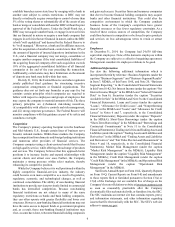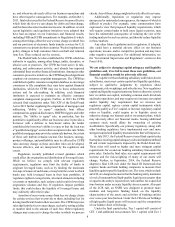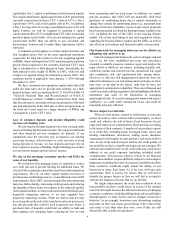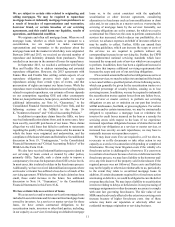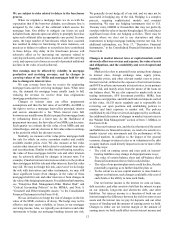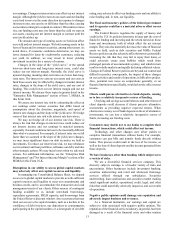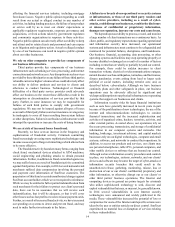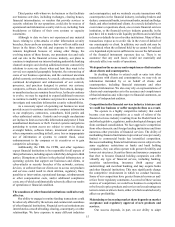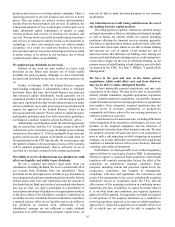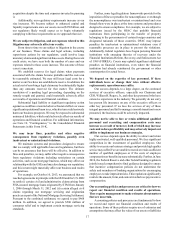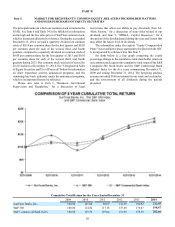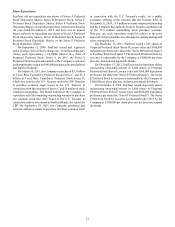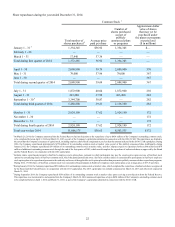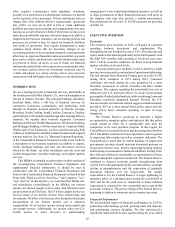SunTrust 2014 Annual Report Download - page 39
Download and view the complete annual report
Please find page 39 of the 2014 SunTrust annual report below. You can navigate through the pages in the report by either clicking on the pages listed below, or by using the keyword search tool below to find specific information within the annual report.16
products and services to evolving industry standards. There is
increasing pressure to provide products and services at lower
prices. This can reduce net interest income and noninterest
income from fee-based products and services. In addition, the
widespread adoption of new technologies could require us to
make substantial capital expenditures to modify or adapt
existing products and services or develop new products and
services. We may not be successful in introducing new products
and services in response to industry trends or developments in
technology, or those new products may not achieve market
acceptance. As a result, we could lose business, be forced to
price products and services on less advantageous terms to retain
or attract clients, or be subject to cost increases, any of which
would adversely affect our profitability.
We might not pay dividends on our stock.
Holders of our stock are only entitled to receive such
dividends as our Board may declare out of funds legally
available for such payments. Although we have historically
declared cash dividends on our stock, we are not required to do
so. Further, in February 2009, the Federal Reserve required
bank holding companies to substantially reduce or eliminate
dividends. Since that time, the Federal Reserve has indicated
that increased capital distributions would generally not be
considered prudent in the absence of a well-developed capital
plan and a capital position that would remain strong even under
adverse conditions. As a result, any increase in our dividend will
require the approval of the Federal Reserve. Refer to the
discussion under the caption “We are subject to capital adequacy
and liquidity guidelines and, if we fail to meet these guidelines,
our financial condition would be adversely affected,” above.
Additionally, our obligations under the warrant agreements
that we entered into with the U.S. Treasury as part of the CPP
will increase to the extent that we pay dividends on our common
stock prior to December 31, 2018 exceeding $0.54 per share per
quarter, which was the amount of dividends we paid when we
first participated in the CPP. Specifically, the exercise price and
the number of shares to be issued upon exercise of the warrants
will be adjusted proportionately (that is, adversely to us) as
specified in a formula contained in the warrant agreements.
Our ability to receive dividends from our subsidiaries could
affect our liquidity and ability to pay dividends.
We are a separate and distinct legal entity from our
subsidiaries, including the Bank. We receive substantially all of
our revenue from dividends from our subsidiaries. These
dividends are the principal source of funds to pay dividends on
our common stock and interest and principal on our debt. Various
federal and/or state laws and regulations limit the amount of
dividends that our Bank and certain of our nonbank subsidiaries
may pay us. Also, our right to participate in a distribution of
assets upon a subsidiary's liquidation or reorganization is subject
to the prior claims of the subsidiary's creditors. Limitations on
our ability to receive dividends from our subsidiaries could have
a material adverse effect on our liquidity and on our ability to
pay dividends on common stock. Additionally, if our
subsidiaries' earnings are not sufficient to make dividend
payments to us while maintaining adequate capital levels, we
may not be able to make dividend payments to our common
stockholders.
Any reduction in our credit rating could increase the cost of
our funding from the capital markets.
The rating agencies regularly evaluate us, and their ratings
are based on a number of factors, including our financial strength
as well as factors not entirely within our control, including
conditions affecting the financial services industry generally.
Our failure to maintain those ratings could adversely affect the
cost and other terms upon which we are able to obtain funding
and increase our cost of capital. Credit ratings are one of
numerous factors that influence our funding costs. Among our
various retail and wholesale funding sources, credit ratings have
a more direct impact on the cost of wholesale funding, as our
primary source of retail funding is bank deposits, most of which
are insured by the FDIC. See Item 7, MD&A, "Liquidity Risk
Management.”
We have in the past and may in the future pursue
acquisitions, which could affect costs and from which we
may not be able to realize anticipated benefits.
We have historically pursued acquisitions, and may seek
acquisitions in the future. We may not be able to successfully
identify suitable candidates, negotiate appropriate acquisition
terms, complete proposed acquisitions, successfully integrate
acquired businesses into the existing operations, or expand into
new markets. Once integrated, acquired operations may not
achieve levels of revenues, profitability, or productivity
comparable with those achieved by our existing operations, or
otherwise perform as expected.
Acquisitions involve numerous risks, including difficulties
in the integration of the operations, technologies, services, and
products of the acquired companies, and the diversion of
management's attention from other business concerns. We may
not properly ascertain all such risks prior to an acquisition or
prior to such a risk impacting us while integrating an acquired
company. As a result, difficulties encountered with acquisitions
could have a material adverse effect on our business, financial
condition, and results of operations.
Furthermore, we must generally receive federal regulatory
approval before we can acquire a bank or BHC. In determining
whether to approve a proposed bank acquisition, federal bank
regulators will consider, among other factors, the effect of the
acquisition on competition, financial condition, future
prospects, including current and projected capital levels, the
competence, experience, and integrity of management,
compliance with laws and regulations, the convenience and
needs of the communities to be served, including the acquiring
institution's record of compliance under the CRA, and the
effectiveness of the acquiring institution in combating money
laundering activities. In addition, we cannot be certain when or
if, or on what terms and conditions, any required regulatory
approvals will be granted. Consequently, we might be required
to sell portions of the acquired institution as a condition to
receiving regulatory approval or we may not obtain regulatory
approval for a proposed acquisition on acceptable terms or at
all, in which case we would not be able to complete the


